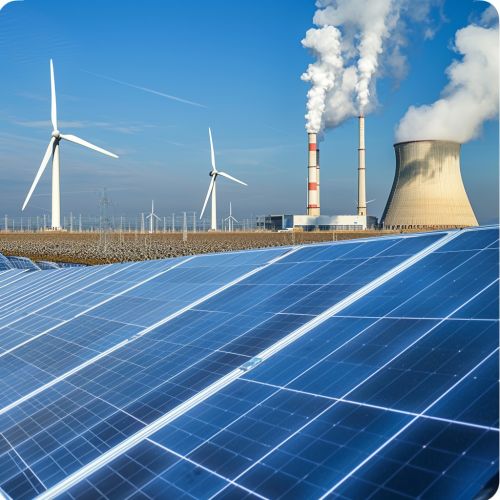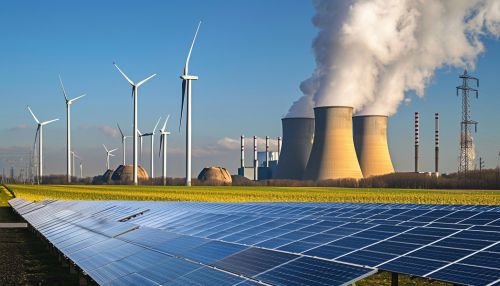Energy resources
Introduction
Energy resources are sources from which energy can be extracted to perform work in a usable manner. Energy, in this context, refers to the capacity of a system to perform work. It exists in various forms such as thermal, chemical, electrical, radiant, and nuclear energy, among others. Energy resources can be categorized into two main types: renewable and non-renewable resources.


Renewable Energy Resources
Renewable energy resources are those that are naturally replenished on a human timescale. They include resources like solar, wind, hydro, geothermal, and biomass energy.
Solar Energy
Solar energy is the energy harnessed from the sun's radiation. The sun emits energy in the form of light and heat, which can be captured and converted into usable power with the help of photovoltaic cells or solar panels. Solar energy is a clean, renewable, and abundant source of power, making it a viable alternative to fossil fuels.
Wind Energy
Wind energy is harnessed by converting the kinetic energy of the wind into mechanical or electrical energy. This is typically done using wind turbines, which rotate when the wind blows, driving a generator that produces electricity. Wind energy is a clean and renewable source of power, and with technological advancements, it is becoming an increasingly important part of the global energy mix.
Hydropower
Hydropower, or hydroelectric power, is generated by harnessing the energy of moving water. This is usually achieved by damming rivers and using the potential energy of the stored water to drive turbines and generate electricity. Hydropower is a renewable and relatively clean source of energy, although it can have significant environmental impacts, such as disrupting aquatic ecosystems and contributing to greenhouse gas emissions.
Geothermal Energy
Geothermal energy is the heat energy stored beneath the Earth's surface. This heat can be harnessed to generate electricity or provide direct heating. Geothermal energy is considered a renewable resource because the Earth's internal heat is continuously replenished by radioactive decay within the planet's core.
Biomass Energy
Biomass energy is derived from organic materials such as plants and animal waste. These materials can be burned directly for heat, or they can be converted into biofuels such as ethanol and biodiesel. Biomass energy is considered renewable because it is based on organic materials that can be regrown.
Non-Renewable Energy Resources
Non-renewable energy resources are those that do not replenish within a human timescale. They include fossil fuels like coal, oil, and natural gas, as well as nuclear energy.
Coal
Coal is a black or brownish-black sedimentary rock that is primarily composed of carbon along with various other elements such as hydrogen, sulfur, oxygen, and nitrogen. It is the largest source of energy for the generation of electricity worldwide.
Oil
Oil, also known as petroleum, is a naturally occurring liquid found in rock formations. It is formed from the remains of ancient marine plants and animals. Oil is used for a variety of purposes, including fueling vehicles, heating homes, and generating electricity.
Natural Gas
Natural gas is a fossil fuel composed mainly of methane, a highly combustible gas. It is used for a variety of purposes, including heating, cooking, and generating electricity. Natural gas is considered cleaner than other fossil fuels as it emits less carbon dioxide when burned.
Nuclear Energy
Nuclear energy is the energy in the nucleus of an atom. Atoms are tiny particles that make up every object in the universe. Nuclear energy can be used to make electricity. But first the energy must be released. It can be released from atoms in two ways: nuclear fusion and nuclear fission.
Conclusion
In conclusion, energy resources play a crucial role in our daily lives. They power our homes, fuel our vehicles, and support our economies. However, the use of non-renewable energy resources has significant environmental impacts, including air pollution and climate change. Therefore, there is a growing emphasis on the development and use of renewable energy resources, which are more sustainable and have fewer environmental impacts.
